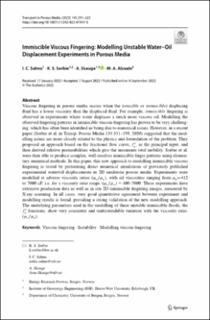Immiscible Viscous Fingering: Modelling Unstable Water–Oil Displacement Experiments in Porous Media
Journal article, Peer reviewed
Published version

Åpne
Permanent lenke
https://hdl.handle.net/11250/3045384Utgivelsesdato
2022Metadata
Vis full innførselSamlinger
- Department of Chemistry [433]
- Registrations from Cristin [9791]
Sammendrag
Viscous fingering in porous media occurs when the (miscible or immiscible) displacing fluid has a lower viscosity than the displaced fluid. For example, immiscible fingering is observed in experiments where water displaces a much more viscous oil. Modelling the observed fingering patterns in immiscible viscous fingering has proven to be very challenging, which has often been identified as being due to numerical issues. However, in a recent paper (Sorbie et al. in Transp. Porous Media 133:331–359, 2020) suggested that the modelling issues are more closely related to the physics and formulation of the problem. They proposed an approach based on the fractional flow curve, f∗w, as the principal input, and then derived relative permeabilities which give the maximum total mobility. Sorbie et al. were then able to produce complex, well-resolves immiscible finger patterns using elementary numerical methods. In this paper, this new approach to modelling immiscible viscous fingering is tested by performing direct numerical simulations of previously published experimental water/oil displacements in 2D sandstone porous media. Experiments were modelled at adverse viscosity ratios (μo/μw), with oil viscosities ranging from μo = 412 to 7000 cP, i.e. for a viscosity ratio range, (μo/μw) ∼ 400–7000. These experiments have extensive production data as well as in situ 2D immiscible fingering images, measured by X-ray scanning. In all cases, very good quantitative agreement between experiment and modelling results is found, providing a strong validation of the new modelling approach. The underlying parameters used in the modelling of these unstable immiscible floods, the f∗w functions, show very consistent and understandable variation with the viscosity ratio, (μo/μw).
